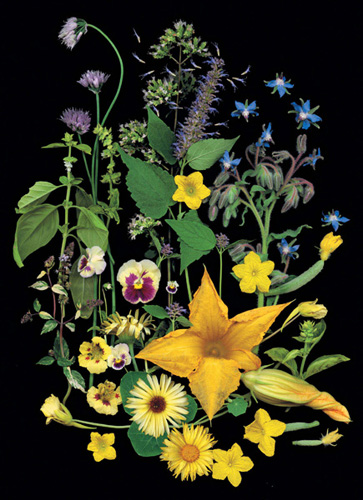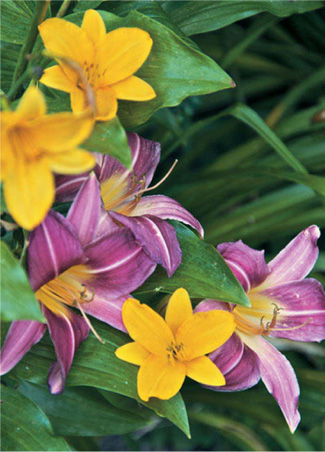
The theme of a garden design could be one devoted to edible flowers: A Allium schoenoprasum (chives); B Origanum vulgare (oregano); C Agastache foeniculum (anise hyssop); D Borago officinalis (borage); E Cucumis sativis ‘Diva’ (cucumber); F Ocimum basilicum (basil); G Curcubita pepo cv. (summer squash); H Calendula officinalis; I Tropaeolum majus ‘Peach Melba’ (nasturtium); J Mentha piperita ‘Variegata’ (peppermint); K Ocimum basilicum ‘Lemon’; L Viola cv. (pansy).

Eating flowers sounds like a somewhat new idea, but humankind has been doing it for centuries. The artichoke is a flower bud, and broccoli is covered with buds. Eating less conventional edible flowers, colorful ones often as garnishes for salads and other dishes, is in fact a more recent mode. Once you’ve tasted a peppery nasturtium, for instance, you’ll find that many flowers may offer more than just their pretty faces. Flowers may be used in drinks, soups, jellies, syrups, flavored oils, vinegars, or fritters.
Not every flower is edible, though. As we’ve learned, many plants are poisonous to humans. Also, don’t eat anything that may have been sprayed with pesticides or herbicides. So, nothing from the florist or picked from the side of the road. And, I am sorry to say, you cannot eat flowers just because they are served in a restaurant. I have witnessed ivy used as a garnish, and worse, oleander—both toxic plants. As a general rule: if in doubt, leave it out.
How about establishing a corner of the garden dedicated to edible flowers? On this page, you’ll find a list of edible flowers describing their flavors or contributions to the table.
When summer’s zucchini plants begin to produce in earnest, you may end up with more fruits than your family can handle, but not if you harvest flowers to eat. Squash blossoms are wonderful filled with flavored ricotta cheese, dipped in batter, and deep fried.
For garnishes, pick flowers in the morning when they are filled with moisture. If you plan to use them soon, float the flowers, cut with a little bit of stem intact, in a bowl of water. To store flowers longer, place them face up on a moistened paper towel set in a covered plastic or glass storage container in the refrigerator.
In most cases, you will be using small flowers whole or pulling petals off of larger ones. Remove fibrous bracts on blossoms like roses, and use the petals. To candy lilacs, rose petals, and violets, dip them in beaten egg white, cover them completely with white sugar, and place them on a rack to dry.
You may want to pluck out the slimy stamens and pistils of larger flowers like daylilies. In one case, however, the part one might think to remove is desirable: The stigma of Crocus sativus is the source of the valuable spice saffron.
Daylilies, and especially yellow ones, are tasty in salads. Flower buds are used in stir-fry.
